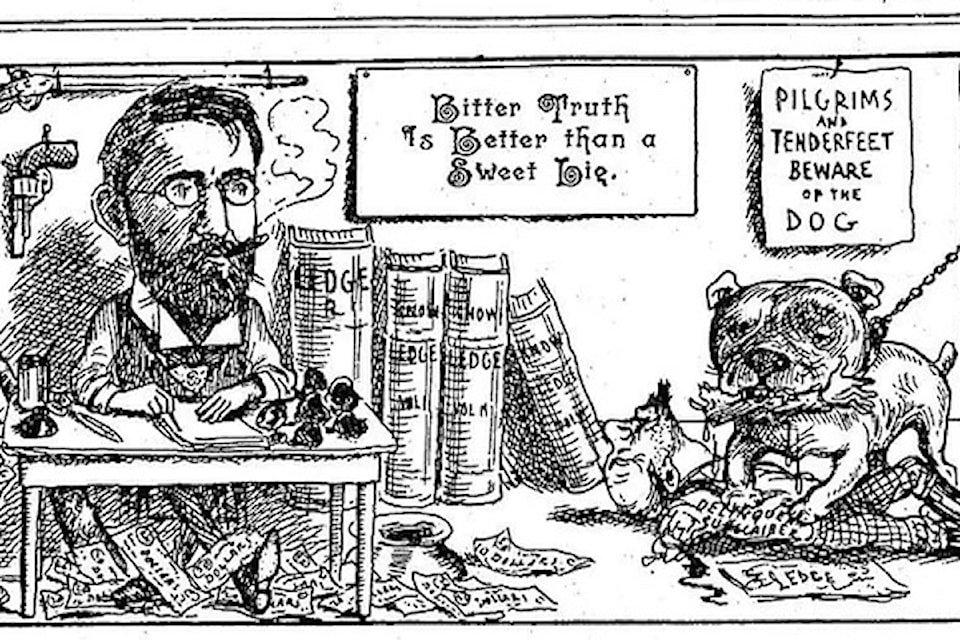Robert T. Lowery’s first venture in the newspaper business was in Petrolia, Ontario in 1879 with his two brothers. He was not yet 20 years of age. They sold that newspaper in 1886. In 1891, he travelled west, first to Vancouver, which was not to his taste. The Slocan beckoned.
In the early 1880s, silver prospectors had congregated at Hot Springs Camp on the west side of Kootenay Lake. The Ainsworth townsite was quickly developed, and a number of mines were soon in operation. In the fall of 1891, Eli Carpenter and John Seaton, departed Ainsworth, and discovered a rich silver deposit on Payne Mountain, above the future site of “The Silver City” of Sandon.
Hundreds of prospectors descended on the Slocan. The silver rush had begun! Within months, 190 claims had been staked. The Payne mine alone yielded one million ounces of silver and lead per year. By the end of the decade, the “Silvery Slocan” hosted hundreds of mines, and the new towns and cities in the region attracted and accommodated thousands of miners and entrepreneurs.
The townsite of Kaslo, also on the west shore of Kootenay Lake, was surveyed in 1891. It quickly became a shipping hub. Silver ore was transferred from wagons and from the Kaslo and Slocan railway to sternwheelers. Goods and mining supplies arrived by steamer and were shipped inland. Kaslo had a population of 3000 in the spring of 1893. It was incorporated as a city later in the year.
“Colonel” Robert Thornton Lowery was, in fact, not a military man. The title apparently referenced his commanding demeanor, though he stood only five feet tall. Despite his penchant for cigars, poker and whiskey, he became the most gifted journalist and newspaper editor in British Columbia.
In 1893, Lowery established his first Kootenay newspaper, the aptly-named the Kaslo Claim. It lasted a mere 16 weeks. The newspaper business in the Slocan was as precarious as the mining industry. The Claim closed, a victim of the collapse in silver prices.
Lowery published the Nakusp Ledge for a time in 1894. In the Ledge, he imaginatively wrote that the road between Kaslo and Nakusp in places “resembles an inland sea,” and that discarded hats along the route led the travelers to “suppose the owners had been drowned in the mud.”
The colonel moved the Ledge to New Denver in December. It survived a decade, during or after which he also published newspapers in a number of other locations, to name a few, Nelson, Fernie and Slocan City, but none for an extended period of time. Lowery launched The Paystreak in Sandon in 1896. His trademark wit was on full display in the first issue.
Under the masthead, he wrote (within a lengthy commentary), “The office of this journal is nearer heaven than any other paper in the province. Its price is in keeping with the altitude.” He added, “This paper owes no apology for its existence. It is on earth for the purpose of helping the locality in which it is published, and also to help its owner to pursue a luxurious and philanthropic career.”
Unfortunately, The Paystreak, did not support the luxury Lowery so boldly chased. After the Great Fire of 1900, Sandon never fully recovered. As silver deposits began to be depleted, Sandon slowly faded. The Paystreak, which shared the market with a competitor, printed its final issue in 1902.
Lowery’s commentaries in his papers were often harsh. Hurled at the federal and B.C. governments and any entity or person abusing their power, his sharp opinions had financial consequences.
The Canadian Pacific Railroad was a regular target. It “was a wonderfully safe road to travel on, and seldom kills a passenger, although occasionally someone dies of heart failure after looking at their freight charges,” Lowery observed wryly.
Due to frequent criticism of the CPR in one of his newspapers, Lowery’s Claim, the CPR barred its sale on their trains. It was a polemic, “devoted to Truth and Humour.” The Post Office, in 1906, also banned it from the mail, having termed it indecent and offensive. That killed it. In the final issue, Lowery railed against Post Office officials who had “foolishly been given tyrannical power.”
The Ledge relocated once more, to Greenwood, in 1904. The colonel published and edited the newspaper until a year before his death in 1921. He had, years before, mused about writing a book. Had Lowery, inspired by the B.C. towns in which he had lived, penned the equivalent of humorist Stephen Leacock’s satiric Sunshine Sketches of a Little Town, it would have been hilarious.
Lowery’s legacy remains today. He was one of the great newspaper editors of Canada’s old west.
A column by Bruce Uzelman
Bruce Uzelman, based in ��������, holds interests in British Columbia history as wells as current political and economic issues.
Bruce had a career in small business, primarily restaurant and retail. He holds a Bachelor of Arts, Advanced from the University of Saskatchewan, with Majors in Political Science and Economics.
Contact: urban.general@outlook.com



